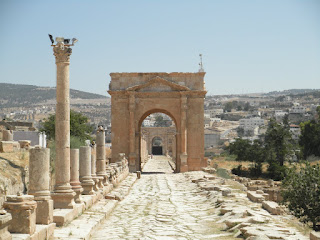I apologize that I haven’t updated this in weeks. I’ve been quite busy with classes, interning, spending time with friends, and an unexpected move in Jordan. However, now that my internship has ended and I’m settled into a new apartment, I really don’t have an excuse not to write.
On July 16, I went on the University-sponsored trip to Jerash and Ajloun Castle, both to the north of Amman. Since I went with the University, we managed to get into both sites for less than $1 each, using the “Jordanian Student” discount.
The first site we visited was the ancient city of Jerash, which was first built by the Canaanites around 2000 BC, but is mostly known for its prosperity as a Roman City from 63 BC – 400 AD. While the city continued to be inhabited after the fall of the Roman Empire around this time, a Persian invasion in 614 AD severely damaged the city. The Umayyads, an early Islamic civilization, rebuilt Jerash, but it was mostly destroyed by an earthquake in 749 AD. The Mamluks and the Ottomans have established small settlements amongst the ruins since that time, but the city continues to mostly be known for its Greco-Roman Architecture.
Examples of such architecture include:
We spent about 3 hours walking around Jerash, which is apparently one of the best preserved sets of Roman Ruins in the Middle East. It was definitely interesting to see how well preserved it was for an ancient city, and I highly recommend it for anyone planning to visit Jordan.
The next place we visited was Ajloun Castle, which was fairly close to Jerash and only took about an hour to explore.

Ajloun Castle was built by the Ayyubids, an Islamic Civilization that fought the Crusaders. The most famous Ayyubid leader was Salah al-Din (Saladin), and it was his nephew that built Ajloun Castle in 1184 AD. However, Ajloun Castle did not see major combat against the Crusaders, but rather was an important site for the battle against the Mongols, who reached Jordan around 1260 AD. An Arab Civilization called the Mamluks ruled the area at the time, and the Mamlukes hold the distinction of being the force most responsible for halting the expansion of the Mongols into the Middle East. Small groups of soldiers continued to use the Castle during the Ottoman Era, but two major earthquakes (in 1837 and 1927) heavily damaged it.

An Arrow Slit, for Medieval Warfare
You’re able to explore the Castle today due to reconstruction work that’s been done, and it’s really interesting to imagine how much history has taken place there. However, one of the best parts of visiting Ajloun Castle was the view of the surrounding area from the very top.
The two historical sites made for a nice day trip, and were only about an hour outside of Amman!
I’ll add more posts about more of my travels shortly.








No comments:
Post a Comment